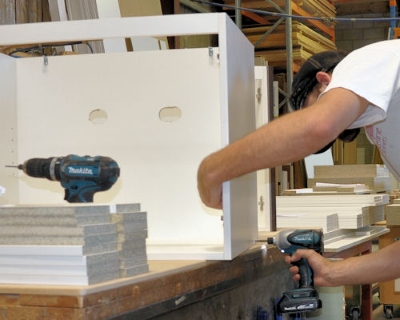Particleboard

Particleboard is also called chipboard, because it’s made from small chips of wood glued together and compressed in a high-temperature press. Different glues are used to bond the fibres, such as:
- Urea formaldehyde – for ‘standard’ grade particleboard not exposed to moisture
- Melamine formaldehyde and urea formaldehyde combined – for ‘moisture resistant’ particleboard used in kitchens, bathrooms and laundries
- Phenol formaldehyde – for high strength sheet flooring.
Various additives are included in particular grades, depending on the properties the board needs to have. For example, paraffin wax is used to increase the board’s resistance to water and to reduce the swelling that occurs if it gets wet. Fire retardants, insecticides and fungicides are also used to improve the board’s durability and performance.
If you look closely at the edge of a sheet of particleboard, you’ll notice that the chips are not all the same size. The board is actually built up in layers. The most common structure is three-layer particleboard, which has fine particles and more adhesive in the two outer layers and a coarse layer in the middle.
Advantages

Particleboard is easy to re-saw and machine. Nails and screws have reasonable holding power when used properly, and joints can be glued for extra strength. It is a very cost-effective substrate for plastic laminates and timber veneers, and it doesn’t swell or shrink, as long as it’s kept dry.
Disadvantages

The biggest weakness of standard particleboard is its inability to resist moisture. Once it gets wet and ‘blows up’, it doesn’t shrink back to its original thickness. Instead, the board loses strength and becomes crumbly where it has swollen. Although moisture-resistant board performs much better than standard board, it still needs to be protected from direct wetting.
Another disadvantage is its rough edge, and inability to hold fasteners tightly when fixed into the edge. ‘Helical’ nails and ‘chipboard’ screws help to overcome this problem by providing more grip with their coarse threads.